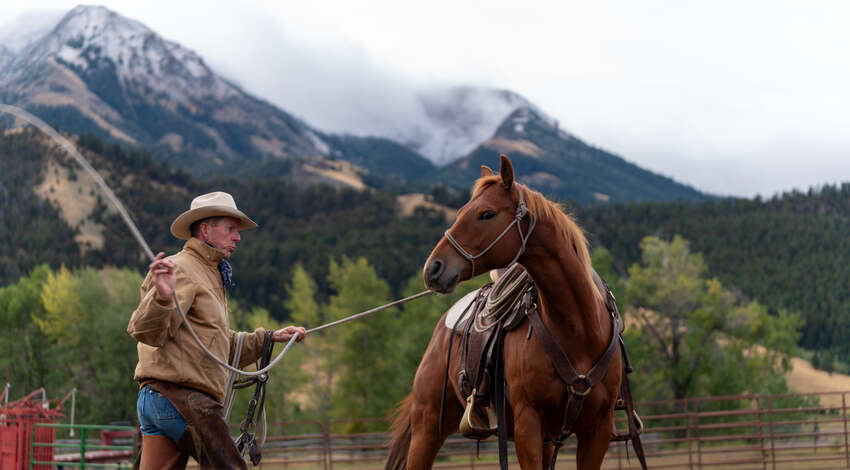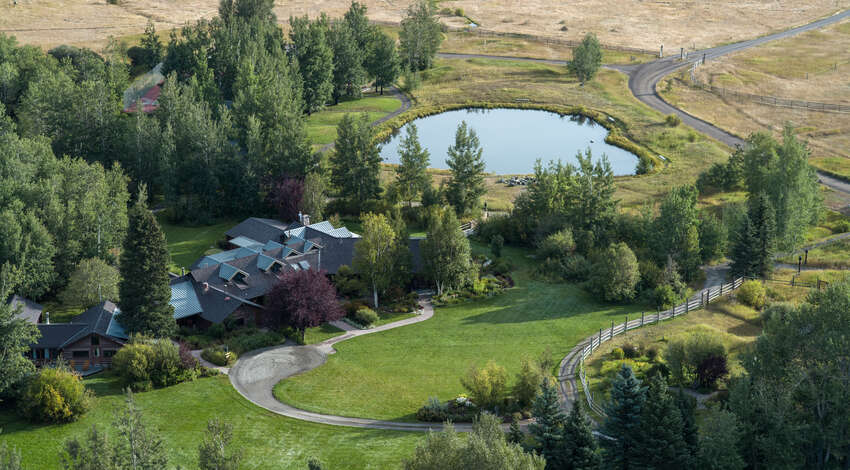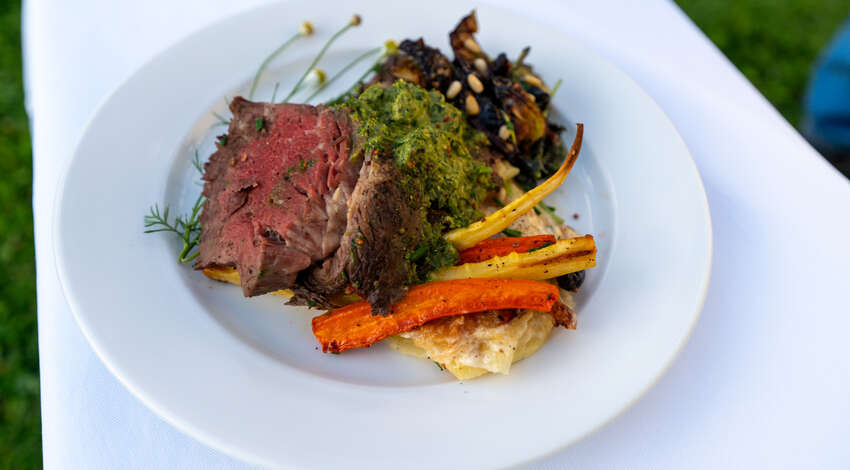Nourishment for the Body and Soul: The B Bar Ranch
What does it take for one of Road Scholar’s learning adventures to receive a flawless five-star culinary rating? The folks at B Bar Ranch have the answers and are happy to share the secrets to their success with Road Scholar participants. With a dash of creativity, years of expertise and a generous serving of passion, the team at the B Bar Ranch works closely together to create an epic Montana experience ripe with natural beauty and gastronomic adventure for all who visit.

A Pristine Setting
Located in the Tom Miner Basin, the B Bar Ranch coexists with nature without trying to change it. The property is surrounded by the natural beauty and tranquility of Montana yet not far from the northern entrance to Yellowstone National Park. “The B Bar is magic,” says Matthew Tousignant, guest ranch manager at B Bar Ranch. “And it’s more than the expansive views, more than the coyotes howling at night and the babbling brooks. It’s all these components together that make this piece of earth sing to your soul.”
This peaceful habitat creates a quintessential haven for nature lovers and native wildlife, including elk, moose, deer, grizzly bears, birds and wolves. This rich, biodiverse landscape also yields exceptional food, including huckleberries (the state fruit), chokecherries, morels (edible mushrooms) and some of the best beef in the country.
Ranch to Table
Matthew works closely with the kitchen team and the land and livestock crew to create a unique, cohesive experience for Road Scholar groups. “Well before our guests arrive, we know everyone’s needs, including gluten-free and vegetarian diets,” says Matthew. Multiple, all-you-can-eat courses for breakfast, midday fare and dinner invite guests to try everything. At lunchtime, you’ll find overspilling sandwiches and beautifully prepared soup and salads, all using locally sourced, seasonal organic produce.
At day’s end, the dinner bell welcomes guests to gather at tables set in white linens. As dishes appear, stories of the day’s adventures are shared. “Dinner at B Bar honors the timeless tradition of gathering — people come together in our historic lodge to enjoy not just delicious meals but to share meaningful conversations, community and connection,” says Matthew.

Uniquely Montana
“We focus on uniquely Montana dishes and take pride in incorporating native Montana huckleberries, juniper berries and our USDA-certified organic, grass-fed B Bar beef in many meals,” says Matthew. “My favorite is the Slow-Roasted Beef Tenderloin with Flathead Cherry Reduction, made with sweet cherries grown in orchards along Northwestern Montana’s Flathead Lake.” (See recipe below.) Garlic mashed potatoes, roasted Brussels sprouts and a bold cabernet sauvignon complete this meal.
Other menu favorites include Authentic Carne Asada Tacos, served with a spicy margarita or cold Mexican lager; Bourbon & Coffee-Rubbed Ribeye Steak, paired with roasted potatoes, grilled asparagus and a smoky Old Fashioned; and Bison Ribeye with Huckleberry & Juniper Glaze, plated with roasted fingerling potatoes and wild dandelion greens. Matthew recommends a glass of Montana-made whiskey or a light, dry pinot noir to complement this meal.
“The Bison Ribeye is a deeply Montana dish that blends traditional Indigenous flavors with modern culinary techniques,” says Matthew. “It’s a stunning, unforgettable meal that pays homage to the land, its history and its natural bounty.” Trout is also a ranch favorite, and Matthew loves the Pan-Seared Trout with an Almond Citrus Glaze. Native Fish Keepers, a nonprofit run by the Salish and Kootenai Tribes of the Flathead Indian Reservation, provides the ranch with fish.
“I want every guest to experience Montana’s palette of flavors,” says Matthew. “At B Bar, we believe in the age-old adage, ‘What grows together, goes together,’ and we hope our guests will grow individually and with each other during their time here,” he says.
B Bar chefs prepare meals with farm-fresh eggs from up the road, or a parsley garnish grown in nearby greenhouses. “There’s no component that, if we can source it in Montana, doesn’t come from Montana,” says Matthew. “It’s quality that you don’t find everywhere. We get astoundingly good organic produce that’s visually stunning and delicious, like heirloom tomatoes, carrots and microgreens from the Hutterites, who are known for what they grow,” he says.

Musical Pastures = Happy, Healthy, Organically Raised Beef
This remarkable Road Scholar learning adventure includes a behind-the-scenes look at how B Bar uses regenerative practices to raise organic beef. The ranching team helps participants appreciate the story behind every meal — from soil health to careful grazing practices to the final dish on their plates.
The B Bar’s 1,200 head of cattle include Angus, Angus crosses and Ancient White Park heritage, divided into three herds: Ancient White Park, finished cattle and younger cattle. The herds rotate between two certified organic grazing locations, the Tom Miner Basin in the summer and the milder pastures in Big Timber over the winter. “Both ranches are certified organic, at the state and national level,” says Mark Rose, land and livestock manager. “Maryanne believes strongly in this principle. The land must be certified for our cattle to be!”
“Our cattle thrive as nature intended: grazing nutrient-rich native pastures at the edge of Yellowstone National Park,” says Mihail Kennedy, production manager.
As stewards of these ancient grasslands, B Bar ranchers ride with their cattle every day to monitor their health and move them to fresh pasture. This mindful rotation works in harmony with nature’s rhythms. In addition to this grazing management, Mihail and his team share their techniques for pasture stitching with diverse plant species and organic composting with Road Scholars.
What Makes B Bar Beef So Special?
- USDA-certified organic cattle are 100% grass-fed, raised and finished on certified organic native pastures, from birth to harvest.
- Cattle benefit from regenerative grazing practices that enhance soil health and biodiversity.
- Approximately 1,200 cattle are divided into three herds and moved every other day to manage their different nutritional needs based on their ages.
- B Bar cattle are free from hormones, antibiotics and chemicals.
- Gentle, low-stress handling ensures the well-being and humane treatment of the livestock.

Handled With Care
Mark Rose, a fourth-generation Montanan, has dedicated his life to agriculture. With his cattle dog, Emmy, by his side, Mark carefully moves B Bar’s cattle from pasture to pasture, depending on the season.
“Emmy’s stock sense makes her essential to our ranching,” says Mark. “We work in extremely steep, difficult terrain, with a lot of timber, where it’s hard for horses or humans to go. She traverses it easily as she gathers cattle.”
Mark always thinks about how moving the cattle affects them. “I don’t want to increase their heart rate,” he says. “Everything my horse, my dog and I do is designed to keep their heart rate down and in a natural frame of mind. We manage them in this gentle way for three reasons: economic, the welfare of the animal and my quality of life,” says Mark.
He sometimes needs to check on a herd while grazing or sleeping, without moving them. “I don’t want to worry them or get them up off the ground,” he says. “I spend a lot of time creating a partnership with my horse to ride through the herd without disturbing them.”
Road Scholars: Always a Pleasure to Host
Mark especially enjoys sharing his knowledge and inspiring change with Road Scholars who care about alternative agricultural practices and long-term land stewardship. “Our last group of Road Scholars included a master gardener, a veterinarian and a farmer,” he says.
Mark always asks the group what they think a cowboy is. Often, he gets the Hollywood version. “I dispel the myths and give them a true, honest picture of what I do,” he says. “I admire Road Scholars for investing in themselves, growing their knowledge, and learning what’s really happening on the ground.”
If you’re looking for an adventure filled with incredible food, beauty and nature, B Bar Ranch is calling your name! As Matthew says, “If you have a deity, whatever it be, and you can’t find it here, then you’re in a rough place. The song of the aspen leaves and Red-winged Blackbirds — everything here is a culmination of all these little things that force us human inhabitants, the last to join the mix, to slow down, be grateful for everything and observe what the land provides.”
Learn more about Road Scholar’s 6-day program, B Bar Ranch: Wildlife & Coexistence on the Edge of Yellowstone.

Slow-Roasted Beef Tenderloin with Flathead Cherry Reduction
Ingredients:
For the Tenderloin:
- 1 whole B Bar beef tenderloin (trimmed, about 3-4 pounds)
- 2 tablespoons olive oil
- 2 tablespoons kosher salt
- 1 tablespoon black pepper
- 1 tablespoon garlic powder
- 1 tablespoon fresh rosemary, chopped
- 1 tablespoon fresh thyme, chopped
For the Flathead Cherry Reduction:
- 2 cups Flathead cherries, pitted and halved
- 1 cup dry red wine (cabernet or pinot noir)
- ½ cup beef stock
- 2 tablespoons balsamic vinegar
- 2 tablespoons honey
- 1 shallot, minced
- 2 cloves garlic, minced
- 1 tablespoon butter
Instructions:
- Prep the Tenderloin: Preheat oven to 250 degrees Fahrenheit. Rub the tenderloin with olive oil, salt, pepper, garlic powder, rosemary and thyme. Let sit at room temp for 30 minutes.
- Slow Roast: Place the tenderloin on a wire rack over a baking sheet. Roast until internal temp reaches 120°F (for medium-rare), about 1.5–2 hours.
- Make the Reduction: In a saucepan over medium heat, sauté shallots and garlic in a little butter. Add Flathead cherries, wine, beef stock, balsamic vinegar and honey. Reduce by half until thickened, about 15 minutes. Strain if a smoother sauce is desired.
- Sear the Tenderloin: Heat a cast-iron skillet over high heat with 1 tablespoon oil. Sear tenderloin on all sides for 1-2 minutes per side. Let rest 10 minutes before slicing.
- Serve: Slice the tenderloin and drizzle generously with the cherry reduction.
Best served with: garlic mashed potatoes, roasted Brussels sprouts and a bold cabernet sauvignon.
